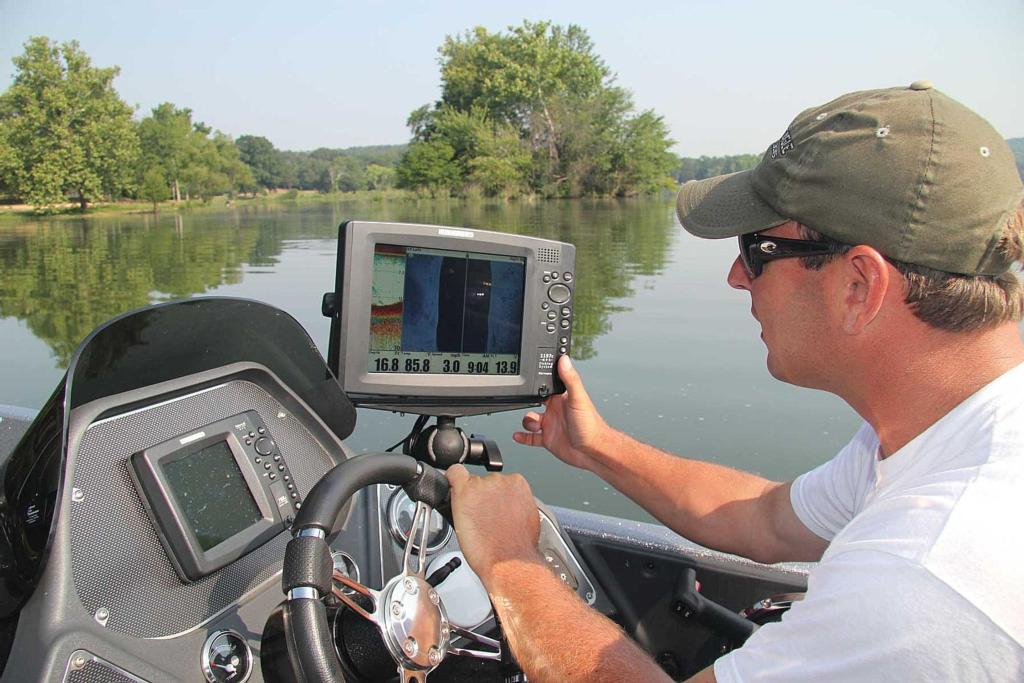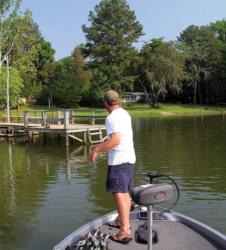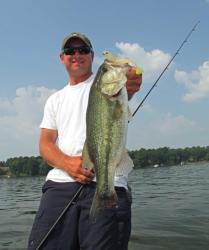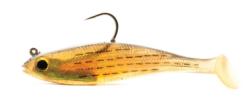Lining up for ledges with Curt McGuire

If this had been a fishing charter, I would have demanded my money back. My day on Pickwick Lake and Lake Wilson with Tennessee pro Curt McGuire was a straight-up lesson in looking – that is, preparing to catch fish, but not necessarily catching them.
McGuire spent the majority of the day staring intently at his depth-finder screen – an essential element of summer success on the Tennessee River – as he prepared for the 2011 EverStart Series Southeast Division tournament.
The drop and heat
McGuire and I meet at Pickwick at around 8 a.m. at the Second Creek boat ramp under a cloudless sky and flat breeze. The heat is already stifling.
 McGuire spends a few minutes flipping and pitching jigs to some docks across the creek from the ramp. He gets a couple of bites from bass that spit the hook, but more importantly, he learns a key bit of information. The waterline on the dock legs and ladders has dropped a couple of inches, indicating that the lake level has come down. Any hopes of a shallow bite, at least in McGuire’s eyes, is shot.
McGuire spends a few minutes flipping and pitching jigs to some docks across the creek from the ramp. He gets a couple of bites from bass that spit the hook, but more importantly, he learns a key bit of information. The waterline on the dock legs and ladders has dropped a couple of inches, indicating that the lake level has come down. Any hopes of a shallow bite, at least in McGuire’s eyes, is shot.
“With this water level and heat, this is all dead water back here,” he says as we head for deeper territory.
Subtle is substantial
On our way to the Second Creek bridge, McGuire stops to examine the creek channel’s contours before heading out to the main-lake ledges. Leaning close to his sonar unit, he studies the images closely and offers a running commentary.
“There. That looks good,” he says of a promising piece of bottom. “That’s a bait school. Those look like white bass – they show up brighter on the depth finder. Now, those are largemouths. See how they’re holding closer to the bottom.”
I follow his finger as it moves from place to place on the screen. The bass are not easy to spot. They look like nothing more than pepper flakes along the contour lines, and they’re holding tight to the ledges.
Years ago, only a handful of experienced anglers truly understood how to maximize the ledge game by locating the turns, points and drops that typically attract fish. Today’s modern electronics have opened up this playing field to anyone with a bottom machine. To excel, anglers like McGuire have learned to recognize valuable subtleties, such as a small rubble pile or a nearly unperceivable nook.
“Sometimes, it only takes a difference of a foot or 2 in depth for them to set up on a spot,” McGuire says. “I’ll find a depth range that I know they like, and then I’ll go look at every little twist and turn. A lot of my day is spent riding around and looking. It’s about as exciting as watching paint dry, but it’s a necessary evil.”
McGuire’s theory is that, to win a ledge-fishing tournament, an angler needs three or four big schools of fish that nobody else has touched. Once they’ve been pressured several times by other anglers, school bass become difficult to catch, and you can’t catch enough of them fast enough in a tournament. Therein lies another tournament strategy: You need to be able to pull up on a place, catch fish quickly and then go to the next spot.
“If you can hit four or five schools, you’ll take your best five out of those 30 or 40 fish you caught and you’ll have a decent bag,” McGuire says.
What they want
Cover and food – those are two of the most important elements of a promising bass spot. However, McGuire only prefers to see the latter on his ledges.
 “If you don’t see bait [on the depth finder], there’s really very little point in stopping, unless you actually see the bass,” he says.
“If you don’t see bait [on the depth finder], there’s really very little point in stopping, unless you actually see the bass,” he says.
As for cover, McGuire has no use for a spot dressed with brush piles. On this trip, he’s looking only for the right bottom contours. When we idle over a brush pile, he keeps moving and never stops to make a cast.
“Where you find brush piles, you’ll find four or five fish,” he explains. “Big schools of bass are normally on clean-bottom spots. They use them more for feeding areas. They might not stay there all the time, but that’s where the big schools will congregate.
“If you put brush piles on a place that was already holding fish, you’ll ruin it. It’s a lot easier for a bass to catch a minnow if he doesn’t have a treetop to get in the middle of.”
Go deep, get bit
Applying these principles on the main-lake ledges, McGuire prospects about a dozen different areas upstream from Second Creek and a few more downstream. He throws a Bomber Fat Free Shad crankbait, but picks up a Strike King Pro-Model Series 6XD crankbait when he needs to push a bit deeper.
 He also works in a Berkley PowerBait Saltwater Power Mullet swimbait occasionally. The swimbait garners a few bites from bass, but they’re practically nibbles. He never manages to hook up with it, and by noon, we’re pulling out and trailering to Lake Wilson.
He also works in a Berkley PowerBait Saltwater Power Mullet swimbait occasionally. The swimbait garners a few bites from bass, but they’re practically nibbles. He never manages to hook up with it, and by noon, we’re pulling out and trailering to Lake Wilson.
Come on current
Afternoon power generation schedules have kept the current minimal in both reservoirs until the last few hours of our day, so we find more active fish in Wilson when we arrive.
McGuire continues prowling the ledges. He pulls up on a spot and makes long casts with a crankbait, keeping the rod tip pointed at the water to allow his lure maximum time in the strike zone. He also leverages his boat’s movement to pull his crankbait deeper.
“I’ll throw as far as I can and use one of two techniques to get a couple of extra feet deeper,” he says. “I might put the trolling motor in reverse and back off of the ledge as I let out more line before reeling. Or I’ll drift up close to the ledge, throw as far as I can and put my trolling motor on about 10, cranking as hard as I can while going the opposite way with the trolling motor.”
The deep-cranking technique works. McGuire lands three keeper bass along with a fat drum, or white perch.
Later, he switches back to the swimbait. Now that there’s current flowing, the fish unload on the lure. McGuire gets four solid blows on the swimbait, and he boats two more keeper bass. Things have definitely picked up.
Spoon trial
 We move again, and McGuire fires out a Strike King spoon in an attempt to coax a stubborn school into biting. No takers.
We move again, and McGuire fires out a Strike King spoon in an attempt to coax a stubborn school into biting. No takers.
Although today the bass snub the spoon, McGuire hasn’t ruled it out. He notes that ripping the shiny metal lure and letting it flutter enticingly in front of the fish can bring crushing strikes that excite the school.
The pro doesn’t spend too much time on it, though. At some point, he says, ledge bass develop a tight case of lockjaw. It’s then that the strategy of locating multiple spots with unpressured fish proves most prudent.
“They’re not going to resume biting if you sit there and keep throwing at them,” he says. “For some reason, a lot of people pick one spot and sit there all day long. But they’re 10 times better off to leave it and come back every hour or so. The fish will be biting again.”
Beat the drum
Between largemouth bites, McGuire hauls in a pair of drum that near the 10-pound mark.
“Drum live where bass live, so I don’t mind catching one at all,” he admits. “They go to the same habitat and the same current breaks. At times, I’ve caught three or four drum and then caught a bass on the next cast.”
He chalks up this spot as a potential one for the tournament, then spends the rest of the day idling around Wilson before calling it quits.
It wasn’t the most jaw-jacking day spent ledge fishing, but that wasn’t the goal. McGuire has assembled a list of potential sweet spots, and he’s eliminated a swath of water. And there’s still plenty more Tennessee River habitat to keep him casting.
Lessons learned
• Drum are clues – Freshwater drum can be an annoying bycatch, but they often inhabit the same areas as largemouth bass, so their presence is a positive sign.
• Brush is bad – Brush piles provide additional cover on a ledge, but this is actually a negative. McGuire seeks out clean ledges with bait and subtle contours that hold bass.
• Look more, fish less – Practice is more about looking at the depth finder than it is about looking at bass in the hand. Get used to using the depth finder, and save the fishing for tournament day.
• Bait is key – Unless you spot bass on the depth finder, the presence of bait is crucial for a spot to produce.
Ledge tournament strategies
Milk run – McGuire likes to find four or five unpressured schools of fish in order to be competitive in a ledge tournament. Pressured fish are less likely to bite quickly, and that hinders his preference to run and gun.
Move on – When ledge fish shut down, persistence is counterproductive. Best to leave the fish for an hour or so and return after they’ve settled.
Fish a variety – Keep a variety of lures on hand on tournament day. Big spoons are great at firing up a school, and jigs and worms can be fished more slowly on bottom.
Think timing – The bite often turns on when current flows, so pay attention to power generation schedules on reservoirs. When damkeepers generate power, they create current, and you’ll want to be on your best spots when it happens.